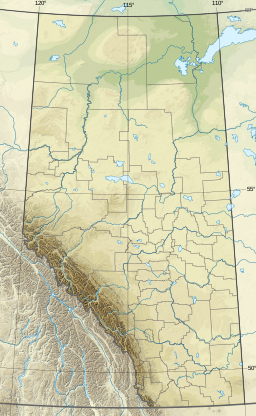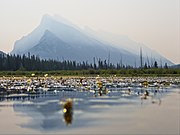- Mount Rundle and Sulphur Mountain as seen from the reeds along the shore of one of the Vermilion Lakes in Banff National Park, Alberta, Canada.
- Winter Vermilion Lakes
- Mount Rundle through the haze of wildfire smoke, as seen from the middle of Vermilion Lake one
| Vermilion Lakes | |
|---|---|
 Mount Rundle and Sulphur Mountain reflected in the lakes | |
| Location | Banff National Park, near Banff, Alberta |
| Coordinates | 51°10′41″N115°35′56″W / 51.17806°N 115.59889°W |
| Primary inflows | Bow River |
| Primary outflows | Bow River |
| Basin countries | Canada |
| Surface area | 0.48 km2 (0.19 sq mi) |
The Vermilion Lakes are a series of lakes located immediately west of Banff, Alberta, in the Canadian Rocky Mountains.
Contents
The three lakes are formed in the Bow River valley, in the Banff National Park, at the foot of Mount Norquay. They are located between the Trans-Canada Highway and the Canadian Pacific Railway tracks. A hot spring is found at the third lake.




